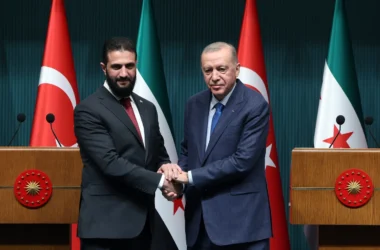As with the Israeli-theatre, the current American administration is signalling its fundamental continuity with Biden-era geopolitical orientation, albeit in different, and in some sense, more transparent, terms, which highlight the importance of resource and energy supply-chains as the animating force in international relations.
In a recent declaration, the President of the United States, Donald Trump, expressed that his administration would continue to provide financial backing to Ukraine’s defence efforts, contingent on gaining access to the nation’s substantial rare earth mineral reserves: “We’re looking to do a deal with Ukraine,” said Trump “where they’re going to secure what we’re giving them with their rare earths and other things.”
Moscow spokesperson Dmitry Peskov stated told the press that: “If we call things as they are, this is a proposal to buy help—in other words, not to give it unconditionally, or for some other reasons, but specifically to provide it on a commercial basis.”
For his part, Ukrainian President Volodymyr Zelensky responded by expressing his readiness to engage in discussions with Trump. This initiative forms a key component of Zelensky’s comprehensive “victory plan,” which was discussed with Kyiv’s allies, including Trump, in the previous fall. The plan not only focuses on military aid but also aims to exploit Ukraine’s natural resources to foster international collaborations.
The Ukrainian Economy Ministry has been proactive in forging alliances with Western nations to tap into these resources, with projections suggesting an investment opportunity of between $12 billion and $15 billion by 2033. Plans include the licensing and development of approximately 100 mining sites, potentially marking a new era of economic growth for Ukraine and strategic resource acquisition for the U.S., amid shifting global supply chains and geopolitical landscapes.
The strategic interest from Trump can be seen as a move to counterbalance China’s dominance in the rare earth market, especially in the context of escalating trade tensions. According to data from the Ukrainian Economy Ministry, Ukraine possesses significant deposits of 22 out of the 34 minerals the European Union deems critical. Beyond rare earths, the country is rich in minerals like titanium, uranium, lithium, beryllium, manganese, gallium, zirconium, and graphite, with one of Europe’s largest lithium reserves essential for emerging technologies like battery production.
Roughly half of Ukraine’s rare earth deposits are currently under Russian control, severely restricting access. The war has also resulted in the loss of control over a significant portion of Ukraine’s coal and metal resources, with estimates indicating up to 40% of metal reserves now lie in territories held by Russia. Despite these setbacks, some lithium deposits in central areas like Kirovohrad remain under Ukrainian control. Yet, the conflict has led to the shutdown of vital mining operations, including a key coking coal mine near Pokrovsk.
The development of these mineral resources faces numerous hurdles, including navigating a complex regulatory landscape, securing access to geological data, and ensuring land availability for mining. New mining projects in conflict zones would require significant investment and, of course, long-term peace.
Crucially, there is a significant military implication to the above: the incentive to retain or take-back resource rich areas. Far from representing a Trump-era de-escalation, as had been long-augured, to the degree that Russia wants to compete for rare earth mineral access, we are seeing a renewed impetus for war.




